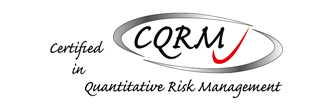Certified Quantitative Risk Management Certification Program and Designation with the IIPER




Real Options Valuation, Inc. is the global preferred provider for the International Institute of Professional Education and Research (IIPER) and our firm has been granted the rights to teach the CQRM IIPER certification courses. On completion of our 4-day seminar and the successful completion of a live test administered on the last day, participants will be granted the CQRM designation! Real Options Valuation, Inc. is one of only three organizations in the world with rights to grant this CQRM designation.
So, how do our seminars compare to others? Surprisingly, our 4-day training seminars are lower in price than other so-called simulation courses, and, at the completion of the training, you will receive your CQRM-IIPER designation, something that other firms cannot provide. You will not only learn the practical applications of risk analysis, but also the theoretical underpinnings of these applications. In addition, the training will be conducted by the exclusive CQRM-IIPER designated trainer, Dr. Johnathan Mun, founder and CEO of Real Options Valuation, Inc. Dr, Mun is a professor; a world-renowned expert on risk analysis; and author of 12 books on the topics of risk, valuation, and strategy; as well as the developer of our Risk Simulator and Real Options SLS software. Compare that to being trained by a fresh college graduate with fewer than two years of experience at other firms or a general MBA with insufficient grounding in the theory/application of risk analysis.
The key advantages of attending one of our seminars are as follows:
The prerequisite for the CQRM-IIPER program is a minimum of a Bachelor's degree or its equivalent and 2 years of experience in financial analysis. Knowledge of basic Excel modeling is a plus but not required.
The International Institute of Professional Education and Research (IIPER) is a global institute with partners and offices around the world including the United States, Switzerland, Hong Kong, Mexico, Portugal, Singapore, Nigeria, Malaysia, and others. CQRM-IIPER certification is accredited by the National Certification Commission, and IIPER is a member of the prestigious AACSB (Association for the Advancement of Collegiate Schools of Business). AACSB is one of the largest U.S. accreditation agencies recognized by the U.S. Department of Education and has over 500 business schools around the world as its members. Further, IIPER's seminars are approved by the Project Management Institute, Inc (PMI)®, and participants can also obtain 30 professional development units (PDU) on completion of the course. IIPER's International Standards Board comprises professors from various universities including Lehigh University (Pennsylvania), University of Applied Sciences (Switzerland), Naval Postgraduate School (California), University of Missouri (Kansas City), and others. IIPER also has strategic alliances and collaborations with various research institutions around the world.

Dr. Johnathan Mun is the software's creator and teaches all these courses. He has consulted for many Fortune 500 firms on risk analysis, valuation, and real options, and has written a number of books on the topic, including Real Options Analysis: Tools and Techniques, 2nd Edition (Wiley Finance, 2005), Real Options Analysis Course: Business Cases (Wiley Finance, 2003), Applied Risk Analysis (Wiley, 2003), Valuing Employee Stock Options Under 2004 FAS 123 (Wiley, 2004), Modeling Risk: Applying Monte Carlo Simulation, Real Options Analysis, Forecasting and Optimization (Wiley, 2006), and others. He is the founder and CEO of Real Options Valuation, Inc., and is responsible for the development of analytical software products, consulting, and training services. He was formerly the VP of Analytics at Decisioneering, Inc., and was a Consulting Manager in KPMG's Global Financial Strategies. Dr. Mun is also a full professor at the U.S. Naval Postgraduate School and a professor at the University of Applied Sciences (Zurich and Frankfurt). He has a Ph.D. in finance and economics, an MBA in business administration, an MS in management science, and a BS in applied sciences. He is certified in Financial Risk Management (FRM), Certified in Financial Consulting (CFC), and Certified Quantitative Risk Management (CQRM-IIPER). He currently resides in California.
The program plus CQRM-IIPER certification costs $2,995 per person. This price includes all the relevant training materials, training for 4 days, and the CQRM-IIPER certification costs. Unfortunately, there are no price discounts when purchased in quantity or with software as the costs are used to cover the CQRM-IIPER fees. Discounts are available on the software when purchased with the training. Please contact us for more information at admin@realoptionsvaluation.com.
In fact, the materials covered are exactly the same. Participants can attend the first 2 days or the last two days of the risk analysis or real options segments, or attend all 4 days and qualify for the CQRM-IIPER certification.
The test is a 50-question multiple choice format that covers the materials taught during the four days and is typically taken at the end of the course. In general, participants who attend all 4 days have a very high pass rate, averaging at 90%, as compared to participants who only attend 2 days (for whatever reason), with a pass rate of only 30%. So, if you attend all 4 days diligently and perform all the tasks in class, you are virtually assured of passing the final certification test.
Yes. For individuals not successful in passing the test the first time, there is a retake opportunity and it is free if taken within 14 days. Otherwise, a processing fee of $50 is assessed. You can retake the test up to three times.
No. Only live seminar participants can obtain the CQRM-IIPER as live instruction and a test are required for the designation. You may elect to do the Training DVD and obtain similar information and knowledge at a lower price, but you are not allowed to take the test or receive the designation on that basis.
PMI is a registered mark of the Project Management Institute, Inc.